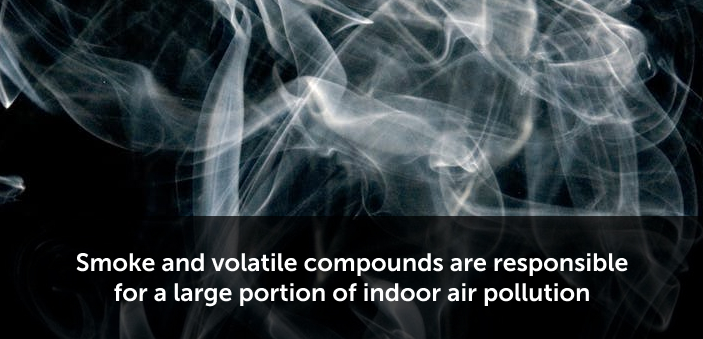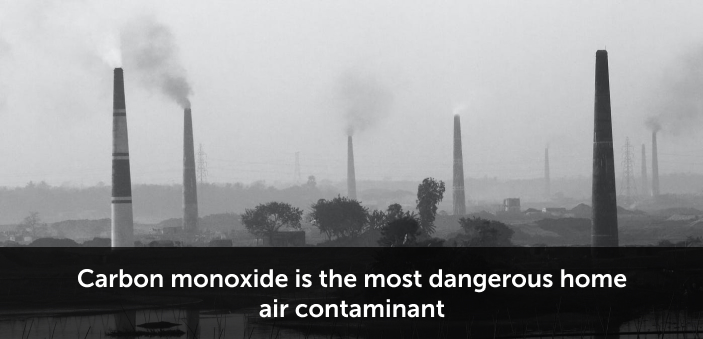How bad is the air in my home?
Humans, by the process of evolution, are well-tuned to threat response. As species evolve and become more advanced, the only ones who survive are those that adapt most effectively to their surroundings.
An animal without a fight or flight response will, in a dangerous situation, become frozen with fear. They are always the first to go. Those who run or fight are more likely to survive, and pass their courageous genes to the next generation.
As such, the cavemen of old were wired to run from, or defend against, sabretooth tigers, angry mammoths, and rival tribesmen. Similarly, today, we run away from, or defend against, muggers, intruders, and any other threat we perceive.
The keyword there, of course, is “perceive”. What if it’s a threat we can’t perceive? Our fight or flight response doesn’t work there - it doesn’t have the chance to. We are then left to preventative measures - ensuring that unperceivable threats don’t make their way to us in the first place.
One of the most common unperceivable threats to our health is bad air quality. Air is, obviously, invisible. And while dangerous contaminants can sometimes make themselves known, like smoke or tear gas, they are often totally invisible as well. These invisible, dangerous contaminants in air are collectively referred to as pollution.
You spend about 90% of your time indoors. This article will expand on the most common causes of dangerous air in the home, what to do if you suspect they are present, and how to prevent pollution from forming in your home in the first place.
Common Causes of Air Pollution in Your House

Studies in home air quality suggest that 96% of homes have some sort of contamination. This vast majority of homes, therefore, need some type of additional filtration or air purification in order to return to healthy levels.
The reasons behind home pollution are numerous, and depend largely on your geographic location and personal habits.
Interestingly, the most common indoor air pollutant is something that seems, at its face, entirely innocuous - moisture.
Moisture forms in a house when the air is warm. Warm air can hold moisture more easily than cool air. This is known as humidity.
That’s right - humidity is considered an indoor air pollutant.
Now, humidity alone won’t hurt you. It’s what the humidity fosters that can. Humid air causes mold and mildew growth. Even the smallest amount of mold or mildew can eject spores into your home’s air. In the long run, breathing in these spores is sure to cause health problems, like fatigue, headaches, and respiratory problems.
Moisture also facilitates the off-gassing of various household chemicals. The most obvious source, household cleaners, can release dangerous ammonia into your air. Lesser known, but equally dangerous, is your furniture. A lot of wood and leather furniture is treated with harsh chemicals. These chemicals dry out or soak in before the furniture is ever sold - but moist air can bring it back out again, releasing it into your air.

The next most common and severe cause of indoor air pollution is volatile organic compounds. Also known as combustion products, these molecules are spewed when you burn wood, gas, or tobacco in your home. Contrary to smoke, which is visible, deposits of volatile organics are often totally imperceivable except, sometimes, by smell.
They hang around, cling to furniture, and are overall not good for your health. Some are even classified as carcinogens.
Dust, bacteria, viruses, and mold are other causes of pollution in your home, although they are natural and bound to enter your home anytime you expose it to outdoor air - for example, opening a door or window.
Perhaps the most famous indoor contaminant is carbon monoxide. Carbon monoxide is an odorless gas which, at any moment, can begin to leak from a gas appliance (stove, water heater, gas fireplace, etc.) Carbon monoxide is extremely, and instantly, toxic. Death can occur within minutes if you are exposed. Don’t worry, we’ll cover how to protect yourself and your family from carbon monoxide in the next section.
What do I do if I find contaminants in my house?
First, in order to find contaminants, you’ll need some way to detect them. There are two ways to do this.
First, you can hire a professional to come to your house and conduct a scan. This is the most comprehensive way to test your air, since they’ll test for basically everything in every part of your house. This, however, will cost a few hundred dollars.
Alternatively, you can buy an air quality detector (some are as cheap as $100), that simply plugs into your wall and continually detects the air in that room. It’s not as comprehensive, but can save you a good amount of money.

Regardless of what you choose, if you discover contaminants, you’ll need to adjust for them.
If you find that your home is too humid, you can invest in a dehumidifier. A dehumidifier grabs air from a given room, draws out the water, and then ejects the dryer air back into the room. The water it draws out will be collected in a tank, which will need to be emptied whenever it becomes full.
If you find a large amount of dust, pollen, or mold in your air, you’ll need an air purifier. These function by bringing in air from a given room, using a filtration system to pluck out the particles, and then ejecting the cleaner air into your home.
In order to detect carbon monoxide, you’ll need a dedicated carbon monoxide detector. These are affixed to your ceiling, and largely resemble a smoke detector. Available at any hardware store, many carbon monoxide detectors actually double as smoke detectors.
If your carbon monoxide detector indicates the presence of carbon monoxide, do not try to find the source of the leak. Your only directive is to get yourself, and your family, out of the house as quickly as possible. Remember, you may only have a few minutes before the carbon monoxide renders you unconscious.

If you live in an apartment building, with many other tenants, you should call 911 and have the police or fire department evacuate everyone. If your apartment had a leak, there’s a good chance other apartments are affected as well.
Even if you live in a house, and you are certain everyone has been evacuated, you should still call 911. Carbon monoxide is extremely flammable, and one spark could cause a neighborhood-wide disaster.
Once safe, call your gas company. Many gas companies have 24/7 assistance available specifically for leaks. If yours doesn’t, you may need to turn off your gas supply on your own and wait until the next day to speak with your gas company.
Have your gas company come and inspect your gas lines and appliances. Once the issue has been fixed, you can resume your normal life!
How To Prevent Home Pollution
Your AC system has a built in filter that grabs contaminants and cleans your air continuously.
This filter, located in your intake vents, will need to be changed at least every three months. For the cleanest air, consider changing it every month.
Air filters are ranked by a number called MERV, or Minimum Reporting Efficiency Value. Filter King offers a wide range of MERVs, from standard MERV 8s, to MERV 10 Carbon Odor Eliminators, to premium MERV 13s.
Check out our online store to find any filter you want, at any size you need!

